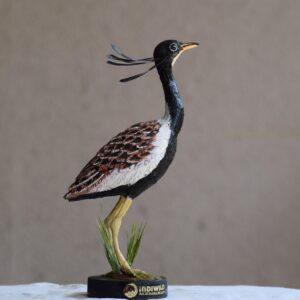Material Used : Polyresin
A resin sculpture is a statue or other piece of three-dimensional art that has been cast using fiberglass resin. Resin is a fairly lightweight, durable material that can be painted and glazed to look like stone, porcelain, bronze or marble. It is used to manufacture a wide variety of products
Kingfisher bird sculpture
Click here to check other beautiful Sculptures on this website
The oriental dwarf kingfisher (Ceyx erithaca), also known as the black-backed kingfisher or three-toed kingfisher, is a pocket-sized bird in the family Alcedinidae.[3][4][5][6] This tropical kingfisher is a partial migrant[7] that is endemic across much of the Indian Subcontinent and Southeast Asia.[5][7][8] It resides in lowland forests, typically near streams or ponds, where it feeds upon insects, spiders, worms, crabs, fish, frogs, and lizards.[7][5] This small bird is easily distinguishable from other birds in its range due to its red bill, yellow-orange underparts, lilac-rufous upperparts, and blue-black back.[9
The oriental dwarf kingfisher is one of the smallest known kingfisher species.[9] It is only slightly larger than a medium-sized hummingbird[9] and measures 12.5–14 cm in length (including bill and tail).[7][9][5] Females typically weigh 14-16g and males 14-21.5g,[5] making the males slightly larger. The two sexes are otherwise alike and sexual dimorphism is not present.[7] Both males and females have a black spot on the forehead; blue and white patches on the side of the neck; a lilac-rufous crown, rump, and tail; a dark blue back and wings; a white chin and throat; pale yellow-orange underparts; a dark brown iris; and red legs, feet, and bill.[7][5] Juveniles are duller and have less lilac colouring; a white chin, throat and belly; yellow-orange bill with pale tip; and blue scapulars and wing-coverts.[5]
This species of kingfisher has three toes, explaining why it is sometimes called the three-toed kingfisher, however, there are other kingfishers which also have three toes.[7] The toe-count in these kingfisher species does not appear to be adaptive.[7]
The oriental dwarf kingfisher is a forest and wetland-dwelling species that is endemic across much of the Indian subcontinent and Southeast Asia.[8][7][5] Populations have been found in Bangladesh, Bhutan, Brunei, Cambodia, China, India, Indonesia, Laos, Malaysia, Myanmar, Philippines, Singapore, Sri Lanka and Vietnam.[8][7][5]
It is most commonly found in deciduous and evergreen primary and secondary forests,[7] but also in alluvial forests, mangroves, overgrown rubber gardens, or in dense aggregations of palms, bamboos, or shrubs.[5] They tend to keep near forest streams and ponds,[7] but their nests are often well away from water.[5] They keep low to the ground and are known to perch and fly within 1-2m of the forest floor.[7] Their preferred habitat is densely shaded forest lowlands near small streams or ponds.[7][14] The lowlands they are present in typically do not exceed 1000-1300m in elevation.[8][7]
Migration
The northern populations winter in the southern parts of the breeding range and the species is defined as a partial migrant.[7] They often migrate south towards peninsular Malaysia from August to September and return north in March.[5][7] Large numbers of night-flying migrants are reported from August to December at Maxwell’s Hill and at Fraser’s Hill in Malaysia, as well as at light stations on many islands up to 60 km off the western coast.[5][7] It is still uncertain whether the most northerly parts of the species’ range are vacated during the winter.[7] The oriental dwarf kingfisher is also a breeding visitor across much of the range in India, but its movements here are still uncertain.[5][7]
Breeding
Egg laying occurs from July to September in southwest India, February to July in Sri Lanka, April to May in northeast India, March to July in peninsular Malaysia, March in Sumatra, and from December to May in Java.[5][7] Nests are built in stream banks, road cuttings, terrestrial termitariums, or in soil near roots of a fallen tree,[5][15] often well away from water.[5] Together, the male and female excavate a horizontal tunnel that is 15–100 cm long, 3.8-4.5 cm in diameter, and ends in an unlined egg chamber.[5][15] One pair dug 25 cm of their burrow, in sand, in about 40 minutes.[5][7] The unlined chamber is 10–15 cm wide and 5–7 cm high.[5] Both the tunnel and egg chamber are inclined upwards, which is thought to minimize water entry into the chamber and to help the flow of waste material out of the nest.[15] The generation time is approximately 4.2 years.[8] A typical clutch size is 3-7 eggs, averaging to around 5 eggs per clutch.[5][15] The eggs are laid in the morning with a one day interval in between.[15] Incubation begins after the final egg is laid and the incubation period lasts 17–18 days.[15] Both the male and female incubate the eggs, however, the female has a larger role in the incubation period because she is responsible for incubating the eggs at night.[15] The fledging period is 18–20 days and chicks typically fledge out in the morning.[15]
Diet
Their diet consists primarily of insects, including mantises (Mantodea), grasshoppers (Orthoptera), flies (Diptera), water beetles (Dytiscidae), winged ants (Formicidae), mayflies (Ephemeroptera); but also includes spiders; worms (Oligochaeta); and small crabs, fish, frogs and lizards.[5][7]
Oriental dwarf kingfishers forage solitarily and perch in low vegetation or on rocks before flying out to capture prey from the ground or from among foliage.[5][7] They can take spiders from their webs and catch insects in flight.[5][7] They can also dive into water for prey at or just below the surface, without submerging themselves.[5][7] Larger prey are typically brought back to a perch, where the bird will strike it repeatedly with its beak before swallowing














Reviews
There are no reviews yet.